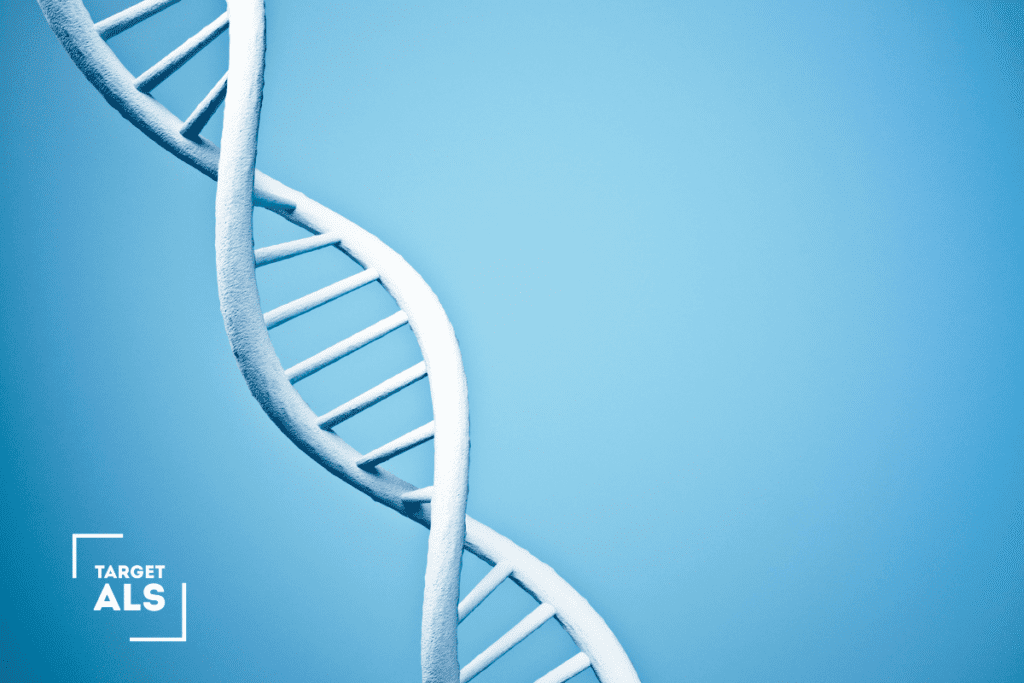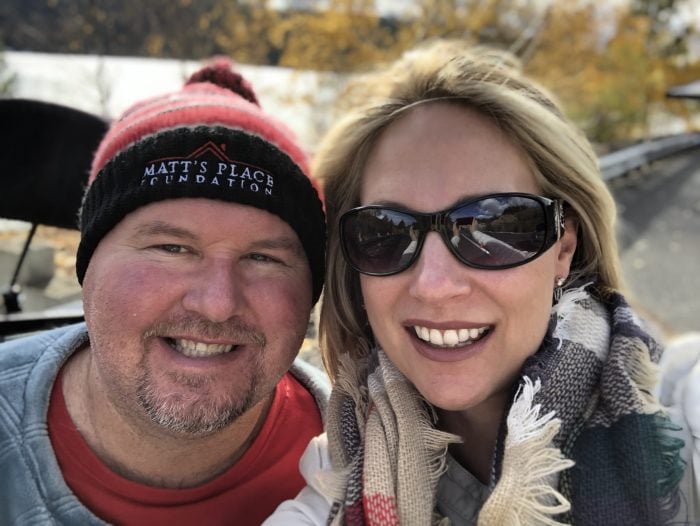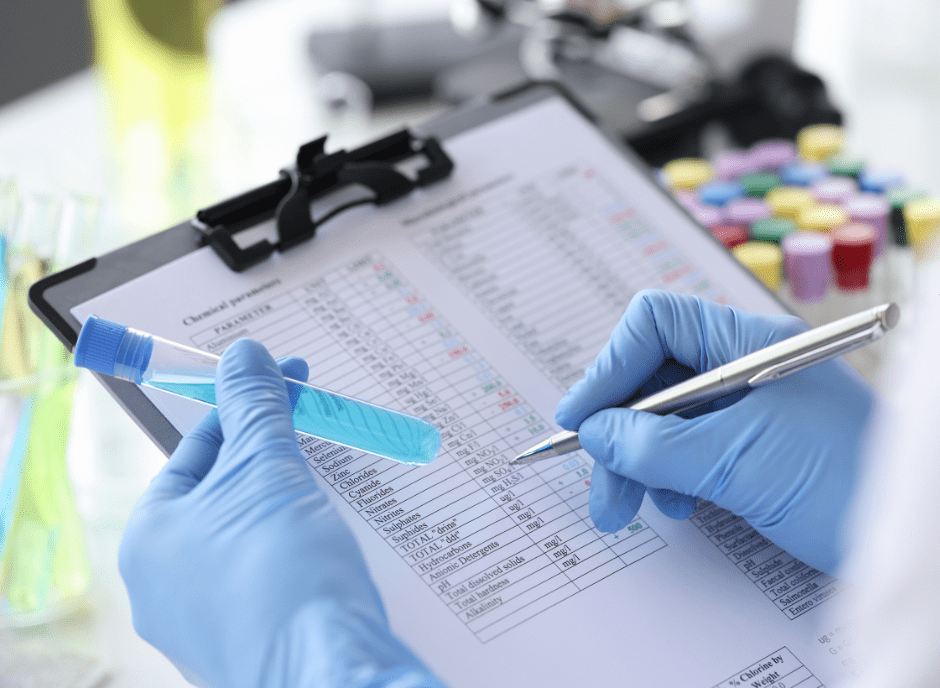Though the exact cause of amyotrophic lateral sclerosis (ALS) is unknown, scientists have discovered that genetics may indeed play a strong role in its development. It’s clear, at least, that ALS often runs in families and that an increased risk of developing ALS correlates with certain mutations in specific genes.
What Is a Genetic Mutation?
Genetic mutations refer to the changes in DNA1 that occur when one or both of the two strands of a double helix is chemically altered. These changes can range from a single nucleotide (the building block of DNA) being changed to whole sections of DNA being deleted or inserted into the sequence.
Mutations can affect any part of the gene sequence, including the base pairs that make up the genes and even the promoter regions that regulate gene expression. Some mutations lead to changes in a single amino acid while others may change multiple amino acids or even whole sections of a protein.
Mutations might have no effect on the structure or function of a protein, and conversely, they may be fatal to an organism’s development or health.2 In some instances, having 2 copies of a mutation (1 inherited from the mother and 1 from the father) is necessary for a disease to manifest; this is known as an autosomal recessive condition. When only one copy of the mutation is needed for the disease to manifest, it is known as an autosomal dominant condition.
The Genetic Basis of ALS
It is estimated that 60% of individuals with familial ALS have an identified gene mutation. The three main genes are: C9orf72 (accounts for 30–40% of familial ALS in the United States and Europe), SOD1 (accounts for 15–20% worldwide), and TARDBP (approximately 5% of cases worldwide).3 Research on the subject is ongoing, but for now, it remains difficult to predict whether having a mutation in one of these genes will lead to disease for a given individual.
Each of these mutations has its own unique characteristics, but they also share some common traits. For example, mutations in those three genes cause proteins to lose their function and become toxic in cells. As a result, other proteins become damaged or die off, which can cause a wide variety of symptoms varying from person to person.
Researchers have observed several symptoms,4 which may be more rare, associated with each of these genes and their mutations:
- C9orf72: Dementia and psychiatric problems
- SOD1: Muscle weakness and wasting
- TARDBP: Muscle weakness and wasting, as well as dementia

Mutations in all three genes affect the frontal and temporal lobes of the brain. Scientists consider these centers as the seat of personality. Damage to these areas has a pronounced effect on emotions, thoughts, behaviors, and actions, resulting in noticeable personality changes, as well as memory loss and dementia.
Causal Pathways of ALS
Determining where and how these mutations occur can help researchers understand the genetic origins of ALS.
The two types of ALS5 are:
- Sporadic ALS (sALS). Patients do not have an inherited form of the disease, but rather, develop symptoms without a clear cause of the development of a genetic mutation. sALS is more common than fALS but has no known cause or risk factors. It occurs randomly throughout society and is not linked to age or sex.
- Familial ALS (fALS). This type accounts for 10% to 15% of all cases and is caused by a genetic mutation that is present in every cell in the body.
It is important to note that those affected by either Sporadic ALS or Familial ALS will be affected in different ways.6 For instance, a person with Familial ALS may have a more rapid rate of progression than someone who develops the disease later in life. Those with Familial ALS will also likely experience a higher number of symptoms, such as muscle weakness and difficulty speaking.
Ongoing Research into ALS Genetic Mutations
The discovery of these genetic mutations has opened up a whole new field of research that will hopefully one day lead to treatments and even cures for ALS and other neural conditions.
A study published in 20177 by a team of researchers investigating the roots of ALS greatly influenced the current understanding of the genetics of ALS. This study investigated the pathogenetic basis of ALS, particularly in terms of genes associated with familial ALS, like C9orf72. These genes were found in people who had inherited the disease from their parents, but they were not present in those who had developed it spontaneously, without any family history.
Meanwhile, more recent studies, such as one published in 20208 in The New England Journal of Medicine, have investigated the effects that different therapeutics can have on genetic mutations, such as using mRNA to target the SOD1 gene for degradation. These studies have shown promising results.
While these studies have increased the understanding of ALS’s precursors, one of the biggest challenges has been to determine how these mutations cause neurodegeneration. To do this, scientists have been working on developing animal models and new therapies that target these mutations in an attempt to treat or prevent neurodegeneration.
Finding Potential Therapeutics for ALS
Investigating the precise genetic mutations that trigger ALS presents one of the most promising avenues for therapeutics. That’s because scientists think neurodegeneration is attributable to the accumulation of misfolded proteins9 inside the neurons themselves.
One strategy, therefore, would be to identify ways to prevent these misfolded proteins from forming. If that could be done, then it might be possible to stop or even reverse neurodegeneration.
Another approach would be to develop therapeutics targeting inflammation in the spinal cord itself. Inflammation in the spinal cord can aggravate misfolded neural proteins10 and hasten the progression of ALS.
There’s a great deal of work yet to be done, but there’s every reason to hope that researchers will find better treatments for ALS and other neurodegenerative diseases in the future.
Frequently Asked Questions:
What is the most commonly mutated gene in ALS patients?
The C9orf72 gene is the most commonly mutated gene among ALS patients. This gene’s mutations make up approximately half of familial ALS cases and are associated with a significant portion of sporadic cases of ALS.
Which protein is often identified in patients with ALS?
The protein often identified in patients with ALS is TDP-43 (TAR DNA-binding protein 43). Abnormal accumulation of TDP-43 is a pathological hallmark in the brains and spinal cords of individuals with Amyotrophic Lateral Sclerosis (ALS).
Is ALS purely genetic or autoimmune?
ALS is not purely genetic or autoimmune; its exact cause is not fully understood. While some cases have a genetic component, with certain gene mutations associated with increased risk, the majority of ALS cases occur sporadically with no clear genetic cause. The role of the immune system in ALS is complex, and while there is evidence of immune system involvement, ALS is not classified as a purely autoimmune disease. The precise interplay of genetic and environmental factors in the development of ALS remains an active area of research.
SOURCES
1. U.S. National Library of Medicine. (n.d.). Amyotrophic lateral sclerosis: Medlineplus Genetics. MedlinePlus.
2. U.S. National Library of Medicine. (n.d.). What is a gene variant and how do variants occur?: Medlineplus Genetics. MedlinePlus.
3. Hou, L., Jiao, B., Xiao, T., Zhou, L., Zhou, Z., Du, J., Yan, X., Wang, J., Tang, B., & Shen, L. (2016, September 8). Screening of SOD1, FUS and TARDBP genes in patients with amyotrophic lateral sclerosis in central-southern China.
4. The genetics of Als. The ALS Association. (n.d.).
5. Causes/inheritance – amyotrophic lateral sclerosis (ALS) – Diseases. Muscular Dystrophy Association. (2021, April 28).
6. Mejzini, R., Flynn, L. L., Pitout, I. L., Fletcher, S., Wilton, S. D., & Akkari, P. A. (2019, December 6). Als genetics, mechanisms, and Therapeutics: Where are we now? Frontiers in neuroscience.
7. van Doormaal, P. T. C., Ticozzi, N., Weishaupt, J. H., Kenna, K., Diekstra, F. P., Verde, F., Andersen, P. M., Dekker, A. M., Tiloca, C., Marroquin, N., Overste, D. J., Pensato, V., Nürnberg, P., Pulit, S. L., Schellevis, R. D., Calini, D., Altmüller, J., Francioli, L. C., Muller, B., … Volk, A. E. (2017, November). The role of de novo mutations in the development of amyotrophic lateral sclerosis. Human mutation.
8. Mueller, C., Al., E., Author AffiliationsFrom the Horae Gene Therapy Center, O. Hardiman and L.H. van den Berg, Others, T. M. and, Others, P. A. J. and, Others, M. L. W. and, Others, L. D. and, Goldstick, J. E., Others, Y. G. and, & Braunwald, E. (2020, July 9). SOD1 suppression with adeno-associated virus and MicroRNA in familial ALS: Nejm. New England Journal of Medicine.
9. Protein misfolding. Protein Misfolding – an overview | ScienceDirect Topics. (n.d.).
10. Liu, J., & Wang, F. (2017). Role of Neuroinflammation in Amyotrophic Lateral Sclerosis: Cellular Mechanisms and Therapeutic Implications. Frontiers in immunology, 8, 1005.





